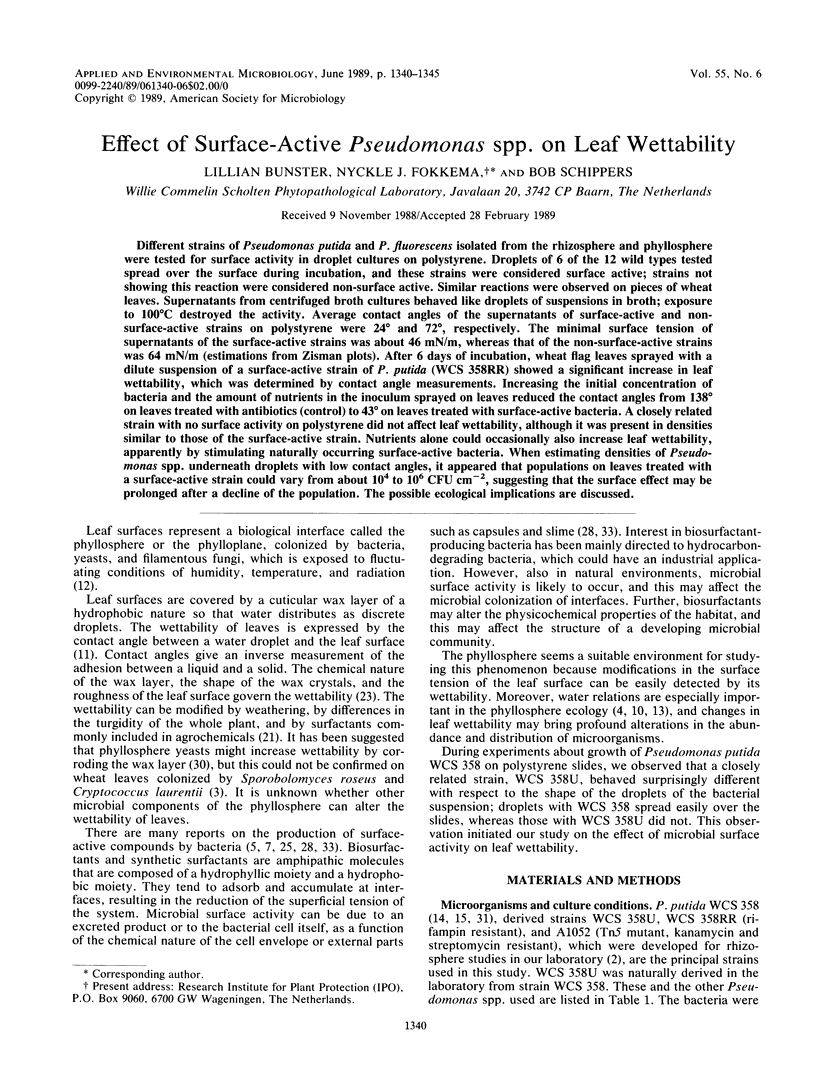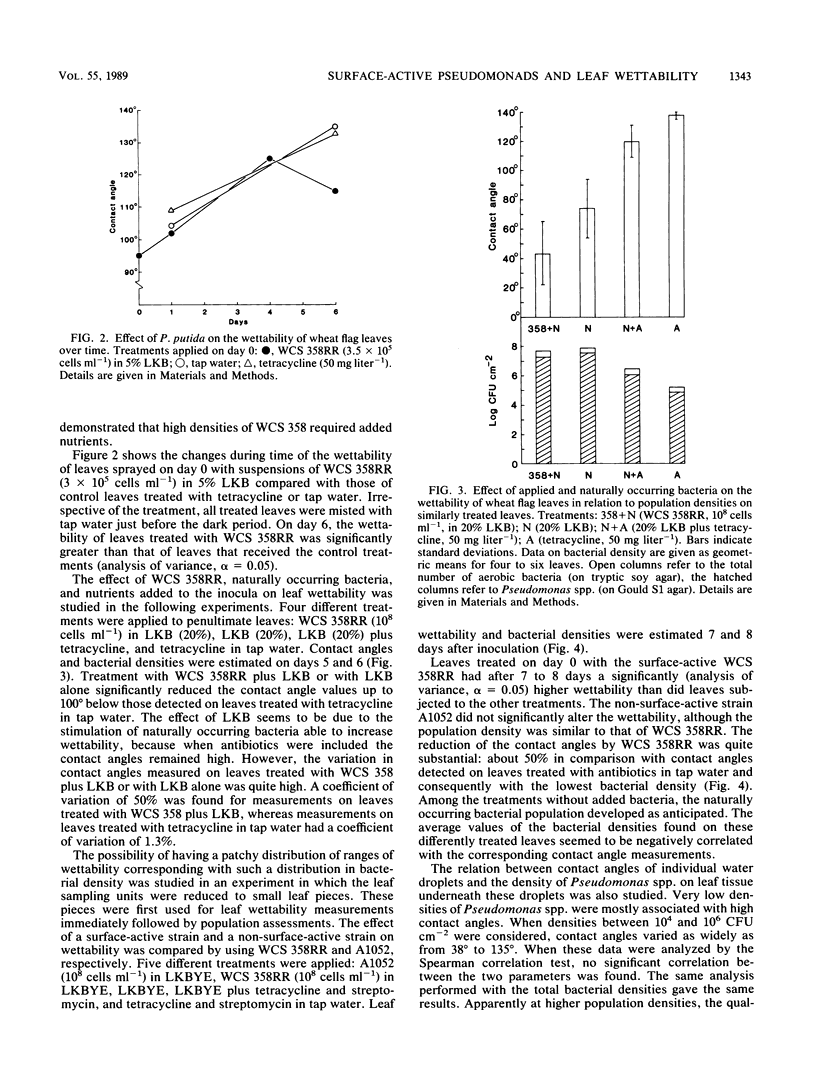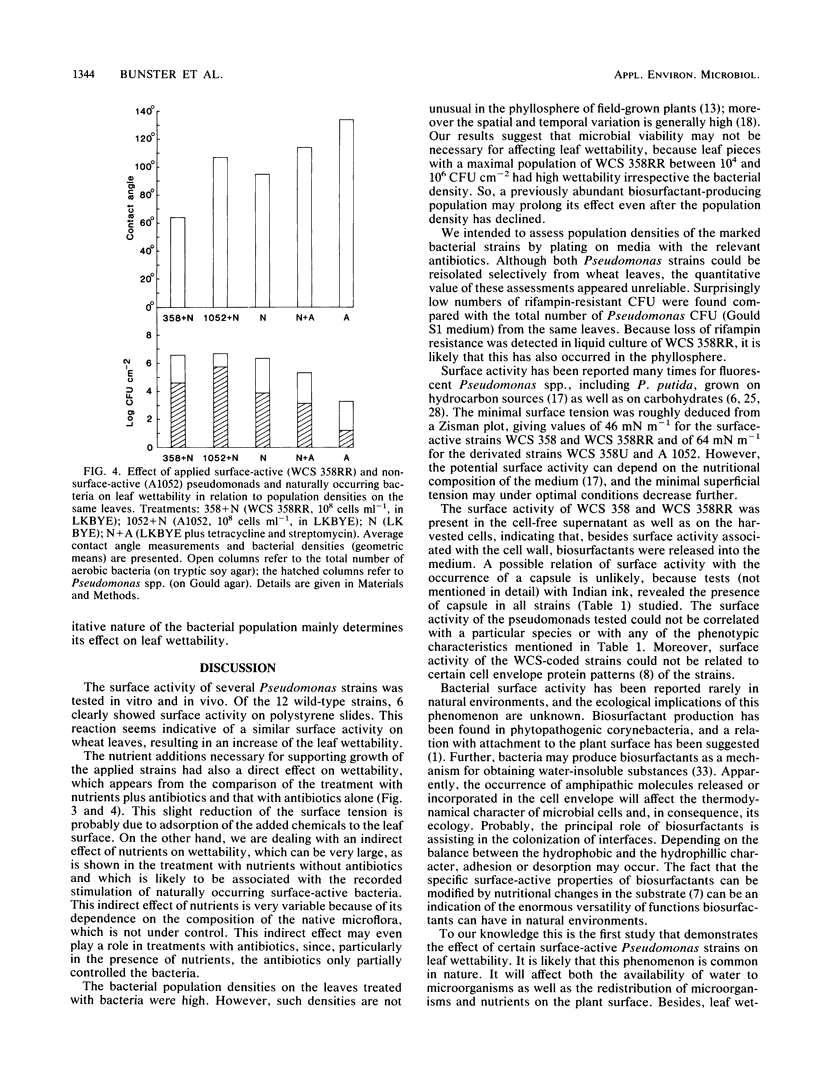Abstract
Different strains of Pseudomonas putida and P. fluorescens isolated from the rhizosphere and phyllosphere were tested for surface activity in droplet cultures on polystyrene. Droplets of 6 of the 12 wild types tested spread over the surface during incubation, and these strains were considered surface active; strains not showing this reaction were considered non-surface active. Similar reactions were observed on pieces of wheat leaves. Supernatants from centrifuged broth cultures behaved like droplets of suspensions in broth; exposure to 100°C destroyed the activity. Average contact angles of the supernatants of surface-active and non-surface-active strains on polystyrene were 24° and 72°, respectively. The minimal surface tension of supernatants of the surface-active strains was about 46 mN/m, whereas that of the non-surface-active strains was 64 mN/m (estimations from Zisman plots). After 6 days of incubation, wheat flag leaves sprayed with a dilute suspension of a surface-active strain of P. putida (WCS 358RR) showed a significant increase in leaf wettability, which was determined by contact angle measurements. Increasing the initial concentration of bacteria and the amount of nutrients in the inoculum sprayed on leaves reduced the contact angles from 138° on leaves treated with antibiotics (control) to 43° on leaves treated with surface-active bacteria. A closely related strain with no surface activity on polystyrene did not affect leaf wettability, although it was present in densities similar to those of the surface-active strain. Nutrients alone could occasionally also increase leaf wettability, apparently by stimulating naturally occurring surface-active bacteria. When estimating densities of Pseudomonas spp. underneath droplets with low contact angles, it appeared that populations on leaves treated with a surface-active strain could vary from about 104 to 106 CFU cm−2, suggesting that the surface effect may be prolonged after a decline of the population. The possible ecological implications are discussed.
Full text
PDF





Selected References
These references are in PubMed. This may not be the complete list of references from this article.
- Cooper D. G. Biosurfactants. Microbiol Sci. 1986 May;3(5):145–149. [PubMed] [Google Scholar]
- De Weger L. A., van der Vlugt C. I., Wijfjes A. H., Bakker P. A., Schippers B., Lugtenberg B. Flagella of a plant-growth-stimulating Pseudomonas fluorescens strain are required for colonization of potato roots. J Bacteriol. 1987 Jun;169(6):2769–2773. doi: 10.1128/jb.169.6.2769-2773.1987. [DOI] [PMC free article] [PubMed] [Google Scholar]
- Guerra-Santos L., Käppeli O., Fiechter A. Pseudomonas aeruginosa biosurfactant production in continuous culture with glucose as carbon source. Appl Environ Microbiol. 1984 Aug;48(2):301–305. doi: 10.1128/aem.48.2.301-305.1984. [DOI] [PMC free article] [PubMed] [Google Scholar]
- KING E. O., WARD M. K., RANEY D. E. Two simple media for the demonstration of pyocyanin and fluorescin. J Lab Clin Med. 1954 Aug;44(2):301–307. [PubMed] [Google Scholar]
- Marugg J. D., van Spanje M., Hoekstra W. P., Schippers B., Weisbeek P. J. Isolation and analysis of genes involved in siderophore biosynthesis in plant-growth-stimulating Pseudomonas putida WCS358. J Bacteriol. 1985 Nov;164(2):563–570. doi: 10.1128/jb.164.2.563-570.1985. [DOI] [PMC free article] [PubMed] [Google Scholar]
- Young D. H., Kauss H. Adhesion of Colletotrichum lindemuthianum Spores to Phaseolus vulgaris Hypocotyls and to Polystyrene. Appl Environ Microbiol. 1984 Apr;47(4):616–619. doi: 10.1128/aem.47.4.616-619.1984. [DOI] [PMC free article] [PubMed] [Google Scholar]
- de Weger L. A., van Boxtel R., van der Burg B., Gruters R. A., Geels F. P., Schippers B., Lugtenberg B. Siderophores and outer membrane proteins of antagonistic, plant-growth-stimulating, root-colonizing Pseudomonas spp. J Bacteriol. 1986 Feb;165(2):585–594. doi: 10.1128/jb.165.2.585-594.1986. [DOI] [PMC free article] [PubMed] [Google Scholar]
- de Weger L. A., van Loosdrecht M. C., Klaassen H. E., Lugtenberg B. Mutational changes in physiochemical cell surface properties of plant-growth-stimulating Pseudomonas spp. do not influence the attachment properties of the cells. J Bacteriol. 1989 May;171(5):2756–2761. doi: 10.1128/jb.171.5.2756-2761.1989. [DOI] [PMC free article] [PubMed] [Google Scholar]


